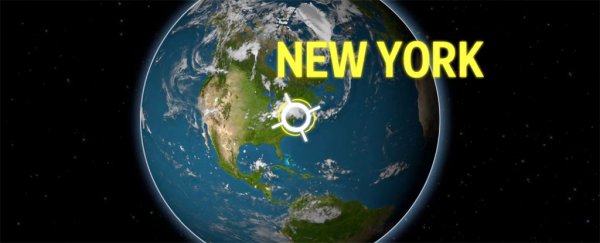There's a perfectly good reason why scientists around the world want to step up efforts to prevent the prospect of an asteroid hitting Earth: in a nutshell, it would only take a small near-Earth object (NEO) to generate massive destruction on the surface, whereas larger NEOs… well, they're dangerous on a whole other scale.
And that's where this awesome Business Insider video comes in. When you're talking asteroids, it can be hard to visualise how NEOs of different sizes would unleash such different levels of havoc on our vulnerable little planet.
But this animation makes it easy to understand, with three simple examples showing how different kinds of space rocks would lead to three very different (but all bad) scenarios if they made landfall at the Big Apple.
In scenario 1, we've got a 12-metre (40-foot) asteroid, approximately the length of a bus, travelling at 19 kilometres (12 miles) per second, and with a density of 8,000kg/m3 (about the same as iron). When it hits the southern tip of New York City, the impact crater takes out the bottom half of the city, with buildings being destroyed over a diameter of nearly 6 kilometres (3.6 miles).
Pretty scary, but nothing compared to what a much larger asteroid could manage. In scenario 2, with a 274-metre (900-foot) rock – about the length of three football fields – travelling at the same speed, the impact crater now extends to much of Brooklyn and Jersey City.
But that's not all. Buildings would be destroyed in a much wider arc, and intense heat would see your clothing ignite well outside of the city. If you were lucky enough to keep your shirt, those within a blast diameter of approximately 140 kilometres (87 miles) would still experience first-degree burns. And that's even with a lower density asteroid of 3,000kg/m3 (the same density as rock).
But even that nightmarish example pales in comparison with the uber-badness of what a really big space rock would do to New York and its surrounds (and their surrounds, and so on).
In our final doomsday scenario, we're about to be hit by an asteroid measuring almost 2 kilometres in length (1.2 miles), which is about five Empire State Buildings stacked on top of one another. Travelling at the same speed and with the density of rock, this bad boy would clean up, well… pretty much a fair chunk of the East Coast and let's just say Canada wouldn't be too happy either.
Check out the video above for the full low-down. And, oh – don't get us started on comets. They're even worse.
